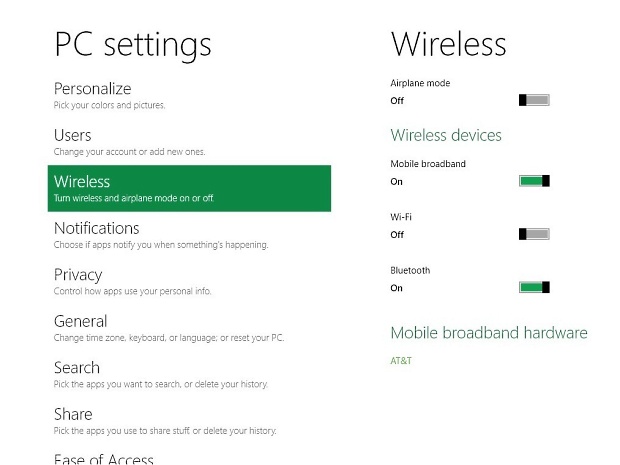Windows 8 aims to simplify mobile networking

The next version of the Windows operating system will make it far easier for users on the move to establish and manage mobile broadband connections, Microsoft said.
Billy Anders, a Microsoft group programme manager on the devices and networks team, outlined the changes in a blog post on Friday. He said that the process would be far simpler than with Windows 7, in which users needed to locate and install third-party drivers and in some cases device-specific software.

Windows 8 will provide users with the option of switching networking radios and features on or off individually. Image credit: Microsoft
"We wanted to eliminate the guesswork in locating and installing device drivers for mobile broadband. We did this by working with our mobile operator and mobile broadband hardware partners across the industry, designing a hardware specification that device makers can incorporate into their device hardware," Anders wrote.
"In Windows 8, we developed an in-box mobile broadband class driver that works with all of these devices and eliminates your need for additional device driver software," he added.
He added that the USB Implementers Forum (USB-IF) have already approved the Mobile Broadband Interface Model (MBIM) specification as standard and that manufacturers have already begun to integrate it into devices, including some that run other operating systems.
As well as simplifying the mobile broadband connection process, Windows 8 will also provide users with fully-integrated radio and connection management options, such as allowing people to turn off features like Wi-Fi, mobile broadband or Bluetooth individually, or all together with the newly introduced flight mode. Previously, people had to rely on manufacturer or device specific software to get the extra functionality that was not native to Windows 7, Anders said.
The connection manager will prioritise Wi-Fi networks over mobile broadband, automatically switching off mobile broadband when connected to a Wi-Fi network, and switching it back on again when not connected to Wi-Fi.
It will also learn which are a user's preferred networks and will prioritise those above unknown connections, or networks that have been manually disconnected from. Anders said Windows 8 will also provider far faster Wi-Fi connection times when resuming a session.
The platform will also provide tools for monitoring data usage when connected to mobile broadband networks to help avoid 'bill shock'. By default, updates for Windows 8 will only be downloaded by default when connected to a non-metered internet connection.
Windows Task Manager will also give users details of exactly how much data each app used and how long the app was in use for while connected to the internet.
Windows 8 also has native support for connecting to different mobile networks, for users with a data SIM card that is not tied to one specific operator. If no data plan already exists, the user can select the network they want to connect to and will then be directed to that operator's data plan pages where they can purchase one.
"Behind the scenes, Windows identifies the mobile broadband subscriber information, looks up the mobile operator in the new Access Point Name (APN) database, and pre-provisions the system to connect to the operator's network," Anders said.
Many operators will also provide apps for managing packages bought from directly from within Windows, providing information and services such as data usage expiry dates, remaining data allowance, manage accounts or get customer support, Anders added.